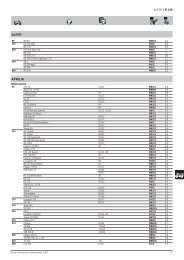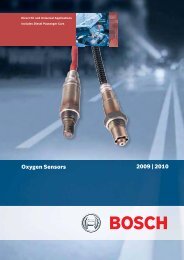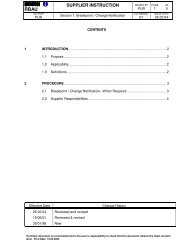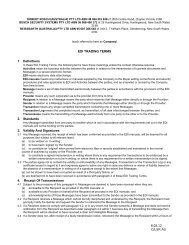For All Vehicles - Bosch Australia
For All Vehicles - Bosch Australia
For All Vehicles - Bosch Australia
You also want an ePaper? Increase the reach of your titles
YUMPU automatically turns print PDFs into web optimized ePapers that Google loves.
Technical Information Technical Information<br />
Sulphation can either occur during storage or if<br />
the battery is installed in a vehicle (or equipment)<br />
that is not used for a long period of time. While<br />
in a vehicle, the battery is constantly drained by<br />
the clock, the alarm system, etc., resulting in a<br />
decrease in the level of charge of the battery and,<br />
after a certain period of time, sulphation of the<br />
plates. However, even a disconnected battery<br />
undergoes sulphation due to self-discharge.<br />
The causes of sulphation can be summed up as<br />
follows:<br />
u There is an excessive lapse of time between one<br />
recharging and the next.<br />
u An engine starter battery is used for “deep<br />
cycles”. This type of battery is not resistant to<br />
deep discharges.<br />
u The battery is undercharged or the charging and<br />
adjustment of levels is carried out incorrectly.<br />
u Low electrolyte level: a battery plate exposed to<br />
air starts to experience sulphation immediately.<br />
Sulphation (lead sulphate) impedes the chemical<br />
reaction between the acid (electrolyte) and the<br />
active material (made up of lead) on the plates<br />
and it prevents normal operation of the battery.<br />
Even after recharging, the voltage will be low<br />
(< 12.4V), but, usually the cells will show equal<br />
values. Sulphation is not a manufacturing defect.<br />
Acid Stratification<br />
Acid stratification is a common cause of battery<br />
failure. In a stratified battery, the electrolyte is<br />
concentrated at the bottom and the top half of<br />
the cell has very little acid. Stratification takes<br />
place when the battery is kept with low charge<br />
(below 80%) and is never fully recharged. Short<br />
journeys that include the use of the windscreen<br />
wipers and electric heaters contribute to this<br />
phenomenon. Acid stratification reduces the<br />
general performance of the battery.<br />
Figure 2 shows a normal battery in which the<br />
acid is distributed evenly from top to bottom.<br />
This battery has good performance because the<br />
correct concentration of acid is distributed evenly<br />
over the plates. Figure 3 shows a stratified battery<br />
in which the acid concentration is light at the top<br />
and heavy at the bottom. A light acid limits the<br />
plate activation, speeds up corrosion and reduces<br />
the performance. On the other hand, high acid<br />
concentration at the bottom artificially increases<br />
the open circuit voltage. The battery seems to be<br />
fully charged, but it delivers low starting power.<br />
High acid concentration also results in sulphation<br />
and further reduces the already low conductivity.<br />
If this condition goes undetected, it will ultimately<br />
result in battery failure.<br />
Figure 2 – Without acid stratification<br />
Figure 3 – With acid stratification<br />
Fully recharging or shaking the battery tends to<br />
correct the problem.<br />
Overcharging<br />
Overcharging is often caused by an unsuitably<br />
high temperature in the engine compartment.<br />
Other than this, a defective voltage regulator is<br />
often another cause of overcharging. A high level<br />
of corrosion, loose particles of positive active<br />
material, damaged active material and high water<br />
consumption are characteristics of overcharging.<br />
A low level of electrolyte and a black layer on the<br />
filler caps are usually evidence for an overcharged<br />
battery. Excessive water consumption leads<br />
to an increase in electrolyte density. Also, a<br />
high temperature results in a lower internal<br />
battery resistance, causing an increase in the<br />
charge current and this increases the effect of<br />
overcharging.<br />
Physical Damage<br />
The battery container and the terminals will<br />
suffer obvious damage if the battery is installed<br />
incorrectly, if the cables are wrongly connected<br />
or if the cables are hammered incorrectly into the<br />
terminals.<br />
In addition, if the terminal poles are melted, this<br />
indicates that the battery has had a short circuit.<br />
(Figure 4.1 and Figure 4.2)<br />
Figure 4.1 – Picture of a melted battery terminal<br />
Figure 4.2 – Picture of a melted battery terminal<br />
Incorrect Application<br />
Batteries recommended by <strong>Bosch</strong> match or exceed<br />
the original equipment specifications. Choosing a<br />
battery of lower capacity or power will result in a<br />
shorter service life and premature battery failure.<br />
Usually, the result is a low charge level together<br />
with the effects described above.<br />
Wear and Tear<br />
During the charging and discharging cycle, the<br />
battery plate material (active material) moves<br />
about due to the electrochemical processes<br />
occurring. Every time that the battery undergoes<br />
a charging or discharging cycle, a small amount of<br />
active material comes loose from the plates. This<br />
normal aging process, caused by the charging and<br />
discharging cycles, results in a loss of battery<br />
capacity and, ultimately, the loss of its capacity<br />
to start the vehicle or power its equipment.<br />
A battery has a finite number of cycles that it<br />
undergoes before losing its capacity. <strong>Vehicles</strong><br />
that do a large number of short journeys, such<br />
as taxis, mini-cabs, trucks and buses, reach the<br />
maximum number of cycles in a shorter time than<br />
vehicles that do longer journeys. As a result, the<br />
batteries used in these types of vehicles may<br />
exhibit the above mentioned symptoms earlier<br />
than expected.<br />
3.5 Checking for Malfunction by Load<br />
Tester<br />
Checking of Appearance<br />
- Damage(Case, Cover, Post)<br />
- Leaking of Acid & ETC..<br />
No Outside Damages<br />
- Check the OCV (not only surface<br />
voltage)<br />
Outside Damages by<br />
User’s Mishandling<br />
- Replace<br />
- Responsibility:User<br />
20 21<br />
OCV is below<br />
12.1(V)<br />
Re-Charge<br />
- Can be hard to<br />
re-charge<br />
- Needs low<br />
current & long<br />
charging time<br />
OCV is about<br />
12.1-12.5(V)<br />
Re-Charge<br />
- Please refer<br />
to charging<br />
procedure<br />
OCV is above 12.5(V)<br />
Perform Load Test<br />
Testing by Battery Checker (Load Tester)<br />
Apply 150A load for 10sec., then check battery voltage<br />
and compare below<br />
Above 9.6 volts<br />
- Good Battery<br />
- Reuse<br />
Below 9.5 volts<br />
- Charge battery and then perform<br />
load test again<br />
* If the battery voltage is still below<br />
9.6V after the second charge and<br />
load test, it should be replaced<br />
4. Inspection, Storage and Stacking<br />
4.1 Inspection on Receipt of Goods<br />
Before unloading the consignment of batteries,<br />
please check the details on the invoice against the<br />
goods delivered and your order details.<br />
Check:<br />
u The battery type.<br />
u The quantities.<br />
u Damaged batteries, batteries that were not<br />
transported in a horizontal position or those with<br />
leakage of electrolyte, should be rejected and sent<br />
back to the supplier, at the carrier’s expense.<br />
u<br />
u<br />
After unloading and before stocking the batteries,<br />
check:<br />
The age of the battery, calculating this from its<br />
date of manufacture.<br />
The open circuit voltage.<br />
u Do a visual inspection (container, cover, terminals,<br />
charge indicator, colours, and labels).















